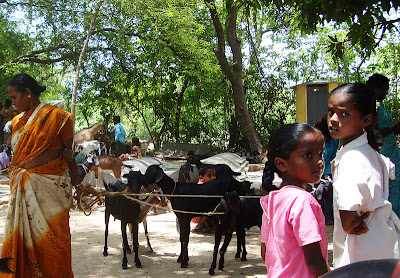 |
| SEVAI Thidalveli Kitchen garden project |
“Kitchen gardens vegetables are for self consumption by poor than marketing” said Ms.Vembu of Thidalveli in the coastal Nagapatinam SEVAI target village. Every house in Thidalveli boasts of a kitchen garden. However, with the change in lifestyle, native recipes have disappeared. Before everything is lost, the self help groups are attempting to bring back the lost legacy in tune with the present trend. Monsoon had supported their efforts to spread the green word. Women showed that biodiversity conservation begins in the kitchen. Each of them played the role of a seed bank, storing tens of varieties and spreading it across. Meeting people in such occasions has helped them develop new ideas and learn growing methods. Coming out of the house to take part in public functions was not easy earlier. The movement has sown the seeds of change even at the family level. Women are now key decision makers. A strong social relationship has developed among these women for a good cause. Vembu, the person who dreamt of such a start, has many more to be groomed. “Though we have developed a good reserve of seeds, fields have acted as banks. We now need to develop a small store for seeds, which would cater to those who are interested. An outlet for native produce may also boost the interest of farmers. We don't want to grow in number, but we want to strengthen ourselves. Being a local group, we want to respond to larger issues,” she says. The kitchen garden is a group-based activity where all the SHG members reap the rewards of this productive new enterprise working on plot preparation, sowing, weeding, watering, nurturing and harvesting the vegetables. The kitchen gardens are non-commercial enterprises where produce is shared equally between the group members that develop and maintain the garden. “We do not sell the surplus vegetables. This self-help group activity and all production from the kitchen garden are for the benefit of our group members,” Vembu clarified. People in the village have seen the tangible benefits of having kitchen gardens, most families have followed suit and developed their own vegetable gardens on varying scales. -Govin




